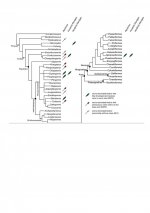Fred Ruhe
Well-known member

Shuo Wang, Wei‐Ling Chang, Qiyue Zhang, Menglu Ma, Feng Yang, De Zhuo, Harn I‐Chen Hans, Rui Yang, Ping Wu, Michael Habib, Wen‐Tau Juan, Cheng‐Ming Chuong, 2020
Variations of Mesozoic Feathers: Insights from the Morphogenesis of Extant Feather Rachises
Evolution/
Accepted Articles
Abstract: https://onlinelibrary.wiley.com/doi/10.1111/evo.14051
The rachises of extant feathers, composed of dense cortex and spongy internal medulla, are flexible and light, yet stiff enough to withstand the load required for flight, among other functions. Incomplete knowledge of early feathers prevents a full understanding of how cylindrical rachises have evolved. Bizarre feathers with unusually wide and flattened rachises, known as “rachis‐dominated feathers” (RDFs) have been observed in fossil non‐avian and avian theropods. Newly discovered RDFs embedded in early Late Cretaceous Burmese ambers (∼99 Ma) suggest the unusually wide and flattened rachises mainly consist of a dorsal cortex, lacking a medulla and a ventral cortex. Coupled with findings on extant feather morphogenesis, known fossil RDFs were categorized into three morphotypes based on their rachidial configurations. For each morphotype, potential developmental scenarios were depicted by referring to the rachidial development in chickens, and relative stiffness of each morphotype was estimated through functional simulations. The results suggest rachises of RDFs are developmentally equivalent to a variety of immature stages of cylindrical rachises. Similar rachidial morphotypes documented in extant penguins suggest that the RDFs are not unique to Mesozoic theropods, though they are likely to have evolved independently in extant penguins.
Enjoy,
Fred
Variations of Mesozoic Feathers: Insights from the Morphogenesis of Extant Feather Rachises
Evolution/
Accepted Articles
Abstract: https://onlinelibrary.wiley.com/doi/10.1111/evo.14051
The rachises of extant feathers, composed of dense cortex and spongy internal medulla, are flexible and light, yet stiff enough to withstand the load required for flight, among other functions. Incomplete knowledge of early feathers prevents a full understanding of how cylindrical rachises have evolved. Bizarre feathers with unusually wide and flattened rachises, known as “rachis‐dominated feathers” (RDFs) have been observed in fossil non‐avian and avian theropods. Newly discovered RDFs embedded in early Late Cretaceous Burmese ambers (∼99 Ma) suggest the unusually wide and flattened rachises mainly consist of a dorsal cortex, lacking a medulla and a ventral cortex. Coupled with findings on extant feather morphogenesis, known fossil RDFs were categorized into three morphotypes based on their rachidial configurations. For each morphotype, potential developmental scenarios were depicted by referring to the rachidial development in chickens, and relative stiffness of each morphotype was estimated through functional simulations. The results suggest rachises of RDFs are developmentally equivalent to a variety of immature stages of cylindrical rachises. Similar rachidial morphotypes documented in extant penguins suggest that the RDFs are not unique to Mesozoic theropods, though they are likely to have evolved independently in extant penguins.
Enjoy,
Fred




